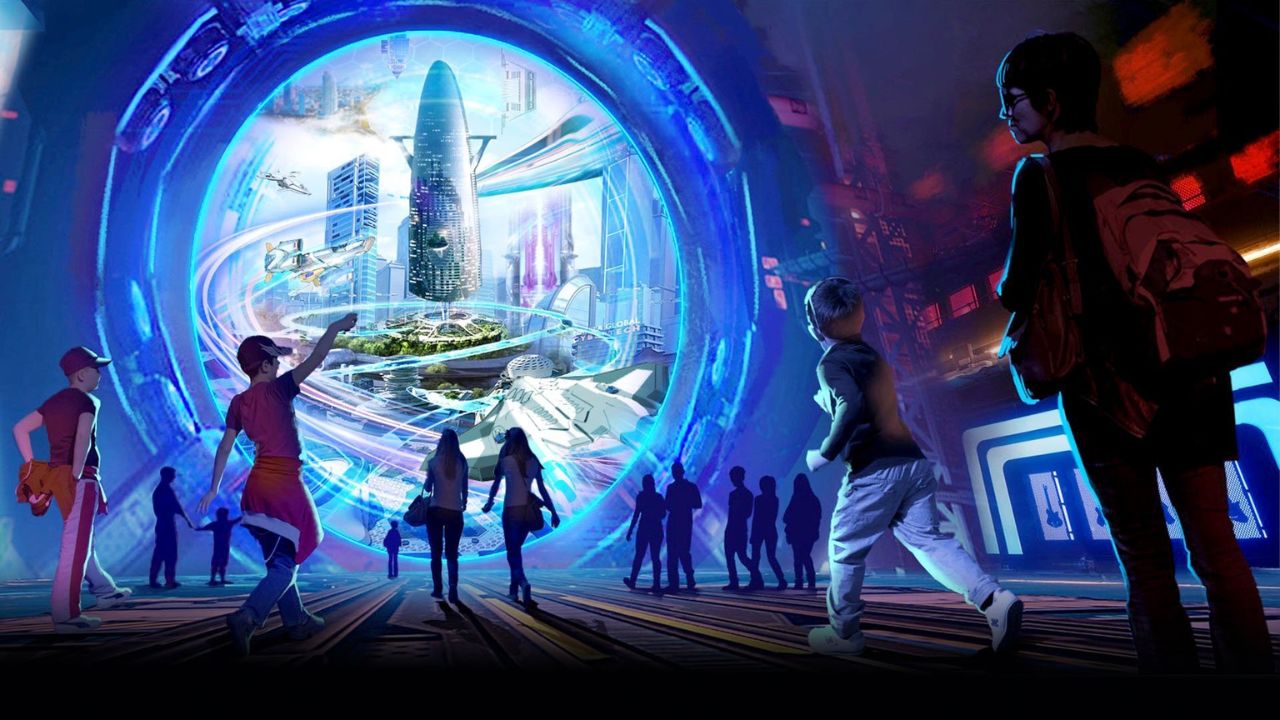Introduction
The concept of the metaverse has been making waves in recent years, capturing the imagination of tech enthusiasts, entrepreneurs, and futurists alike. But where did it all begin? Who first had the vision of a virtual universe where people could interact and engage with each other and digital content? In this article, we will explore the origins of the metaverse and the key figures who played pivotal roles in its development.
The metaverse, a term coined by science fiction writer Neal Stephenson in his novel Snow Crash, refers to a collective virtual shared space that is created by the convergence of virtually enhanced physical reality and physically persistent virtual reality. It is an immersive online world where users can not only interact with each other but also explore endless possibilities and experiences that go beyond traditional online platforms.
Science fiction has long been a source of inspiration for technological advancements, and the concept of the metaverse is no exception. Books, movies, and television shows have depicted futuristic worlds where people can escape reality and enter virtual realms. These visions have fueled the imaginations of many pioneers who sought to bring these fictional worlds to life.
The early beginnings of the metaverse can be traced back to the emergence of virtual reality technology. In the 1980s, Jaron Lanier, often referred to as the “father of virtual reality,” pioneered the development of immersive computer-generated experiences. His work laid the foundation for the immersive and interactive virtual worlds that would later evolve into the concept of the metaverse.
Neal Stephenson’s novel, Snow Crash, published in 1992, introduced the world to the concept of the metaverse. Stephenson described a virtual reality universe called the Metaverse, where users could interact with each other and navigate through a vast digital landscape. His innovative depiction of the metaverse sparked further interest and inspired a new generation of technologists to turn the concept into reality.
The Birth of the Metaverse
The birth of the metaverse can be attributed to the convergence of various technological advancements and the vision of forward-thinking individuals. It was a culmination of ideas and innovations that laid the foundation for the virtual universe we know today.
One of the key milestones in the creation of the metaverse was the development of virtual reality (VR) technology. In the 1980s, Jaron Lanier, a computer scientist and philosopher, pioneered the concept of virtual reality and coined the term “virtual reality.” Lanier’s groundbreaking work focused on creating immersive and interactive experiences, where users could enter and explore computer-generated worlds. His vision laid the groundwork for the immersive and interactive virtual environments that are essential components of the metaverse.
Another significant contribution to the birth of the metaverse came from the realm of science fiction. In his 1992 novel Snow Crash, Neal Stephenson introduced the world to the concept of the metaverse. Stephenson envisioned a future where people could escape the confines of reality and immerse themselves in a vast virtual universe. In this metaverse, users could interact with each other, explore digital landscapes, and engage in various activities. Stephenson’s novel not only popularized the term “metaverse” but also inspired countless technologists to pursue the realization of this virtual realm.
As technology continued to advance, early attempts at creating the metaverse began surfacing. In the late 1990s, several virtual worlds and online communities emerged, aiming to offer immersive and interactive experiences to their users. Platforms like Second Life, Active Worlds, and There.com allowed users to create avatars, explore virtual environments, and interact with one another. These early virtual worlds laid the groundwork for the metaverse, demonstrating the potential of virtual reality and the possibilities of digital interactions.
In recent years, the concept of the metaverse has gained traction and sparked renewed interest from tech giants and innovators. Companies like Epic Games and Facebook have set their sights on building their own versions of the metaverse. Epic Games, led by visionary Tim Sweeney, aims to create a virtual world with its popular video game Fortnite at its core. On the other hand, Mark Zuckerberg, the CEO of Facebook, envisions a metaverse that transcends gaming, offering social experiences, commerce, and education.
The birth of the metaverse is an ongoing process, continuously evolving as technology advances and new ideas emerge. It represents a future where individuals can transcend physical limitations and immerse themselves in digital realms. As the metaverse continues to develop, it holds the potential to revolutionize the way we interact, communicate, work, and entertain ourselves.
Origins of the Concept
The concept of the metaverse didn’t materialize overnight; it has roots in various fields and ideas that have shaped its evolution. By exploring the origins of the concept, we can gain a deeper understanding of its foundation and the influences that have contributed to its development.
Science fiction has played a significant role in introducing and popularizing the idea of the metaverse. Authors like William Gibson, Vernor Vinge, and Neal Stephenson have depicted virtual worlds in their novels, where individuals can escape reality and engage in immersive experiences. It was Stephenson’s novel Snow Crash, published in 1992, that introduced the term “metaverse” and provided a detailed vision of a virtual universe where users could interact and explore digital landscapes. Stephenson’s work resonated with the technological and creative communities, and his portrayal of the metaverse became a blueprint for many subsequent virtual reality endeavors.
In addition to science fiction, the field of augmented reality (AR) and virtual reality (VR) has been instrumental in shaping the concept of the metaverse. AR overlays digital elements onto the real-world environment, enhancing our perception and interactions. VR, on the other hand, immerses users into entirely computer-generated environments. The potential of these technologies to create immersive experiences and blur the line between physical and digital realities formed the basis of the metaverse concept.
Another key influence on the metaverse concept is the rise of virtual worlds and online communities. Platforms like Second Life, created by Linden Lab in 2003, allowed users to create avatars and interact in a vast and customizable virtual world. Users could socialize, engage in commerce, and even create their own digital content. These early virtual worlds demonstrated the feasibility and appeal of a metaverse-like experience, paving the way for further exploration and development.
The evolution of the internet and its capabilities has also been a catalyst in the development of the metaverse concept. As internet speeds increased, and the capacity for data transfer improved, the idea of creating a seamless and interconnected virtual universe became more attainable. The metaverse aims to transcend the limitations of traditional internet-based experiences, providing a more immersive and interactive space where users can engage with one another and digital content in a seamless manner.
It is essential to recognize that the origins of the metaverse concept are multi-faceted, drawing inspiration from science fiction, augmented and virtual reality, virtual worlds, and the evolution of the internet itself. These various influences have converged to create a collective vision of an interconnected virtual universe that holds immense potential for socialization, entertainment, education, and more.
Science Fiction Influence
Science fiction has long been a source of inspiration for technological advancements, and it has played a significant role in shaping the concept of the metaverse. The imaginative works of science fiction authors have not only captivated readers but also sparked the imaginations of innovators and technologists who have sought to bring these fictional worlds to life.
Authors like William Gibson, Vernor Vinge, and Neal Stephenson have envisioned virtual worlds and digital realms in their novels, where people can escape the constraints of reality and immerse themselves in new and exciting experiences. Their depictions of these virtual universes have provided a blueprint for the development of the metaverse as we understand it today.
One of the seminal works of science fiction that heavily influenced the concept of the metaverse is Neal Stephenson’s novel Snow Crash, published in 1992. In Snow Crash, Stephenson introduces the term “metaverse” and describes a fully-realized virtual reality universe where users can interact with one another and explore a vast digital landscape. This virtual universe, known as the Metaverse in the novel, becomes a central aspect of the story and is widely regarded as a key inspiration for the development of the metaverse concept in reality.
Stephenson’s portrayal of the metaverse presented a vivid and immersive vision, showcasing the potential for a digital realm where individuals could transcend physical limitations and engage in a wide range of experiences. The idea of a shared virtual space, with its own rules and possibilities, sparked the imaginations of creators and technologists, inspiring them to work towards the realization of a metaverse-like environment.
Other science fiction authors have also contributed to the development of the metaverse concept. William Gibson, often credited with coining the term “cyberspace” in his novel Neuromancer, imagined a digital landscape where users could navigate and interact with vast amounts of information. The idea of a virtual realm built upon interconnected networks resonated with the future development of the metaverse.
Vernor Vinge’s novel Rainbows End depicts a future where augmented reality allows users to overlay digital information onto their physical surroundings. This portrayal aligns with the blending of physical and digital realities that is central to the metaverse concept.
It is clear that science fiction has been instrumental in shaping the metaverse as a concept and providing a glimpse into the possibilities of a virtual universe. These creative works have captured the imaginations of many who have sought to turn these visions into reality, driving the exploration and innovation towards the creation of immersive and interconnected digital spaces.
Virtual Reality and Early Attempts at the Metaverse
Virtual reality (VR) technology has played a crucial role in the development of the metaverse concept. The ability to immerse oneself in computer-generated environments, coupled with interactive experiences, provided a stepping stone towards the realization of a fully-fledged metaverse.
In the 1980s, computer scientist and philosopher Jaron Lanier pioneered the concept of virtual reality. His work focused on creating immersive experiences where users could interact with computer-generated worlds. Lanier’s efforts laid the foundation for the development of VR technology, shaping the metaverse as we know it today.
Early attempts at creating the metaverse began to emerge as virtual reality technology evolved. In the late 1990s, platforms like Second Life, Active Worlds, and There.com gained traction as virtual worlds that allowed users to explore, interact, and create their own digital content.
Second Life, created by Linden Lab in 2003, was one of the most notable examples of this early attempt at the metaverse. It offered users an immersive and customizable virtual world where they could socialize, engage in commerce, and even build their virtual properties. The platform demonstrated the potential for a metaverse-like experience, where individuals could interact with one another and engage with digital content in a shared virtual space.
While these early virtual worlds laid the groundwork for the metaverse, they also had limitations. The experiences were often siloed, and interoperability between platforms was limited. Users were restricted to the specific environment of each virtual world, and seamless interaction between different platforms was challenging.
Additionally, technological limitations posed challenges in creating truly immersive and realistic experiences. The hardware required for VR, such as headsets and motion controllers, was expensive and not widely accessible. This limited the adoption and widespread use of VR technology.
Despite these challenges, these early attempts at the metaverse were valuable in demonstrating the potential of virtual worlds and immersive experiences. They set the stage for further exploration and development, inspiring technologists and entrepreneurs to push the boundaries and create more advanced and interconnected virtual spaces.
The Visionaries Behind the Metaverse
The development of the metaverse as a concept and its pursuit as a reality have been driven by a select group of visionaries. These individuals have recognized the potential of creating immersive and interconnected virtual spaces and have played pivotal roles in advancing the metaverse movement.
Jaron Lanier, often referred to as the “father of virtual reality,” is among the key visionaries behind the metaverse. In the 1980s, Lanier’s pioneering work in virtual reality laid the foundation for immersive computer-generated experiences. His efforts to create interactive and engaging virtual worlds served as the building blocks for the metaverse concept we know today.
Neal Stephenson, renowned science fiction author, greatly influenced the metaverse through his novel Snow Crash. Published in 1992, Snow Crash introduced the term “metaverse” and presented a detailed vision of a virtual reality universe. Stephenson’s imaginative portrayal of the metaverse inspired many technologists and entrepreneurs to pursue the realization of such a world.
Tim Sweeney, the founder of Epic Games, is another visionary driving the metaverse forward. Epic Games is known for developing the popular video game Fortnite, which has become a cultural phenomenon. Sweeney believes that Fortnite can serve as a foundation for a metaverse-like experience, envisioning a future where users can socialize, create, and explore within the Fortnite universe.
Mark Zuckerberg, co-founder and CEO of Facebook, has also expressed a strong interest in the metaverse. At the Facebook Connect conference in 2021, Zuckerberg outlined his vision for the company’s future, emphasizing the importance of building a metaverse that goes beyond gaming. He envisions a connected virtual space where users can work, interact, and engage in a wide range of activities.
These visionaries share a common goal: to create a metaverse that transcends the boundaries of traditional online platforms. They believe in the power of immersive and interconnected virtual spaces to revolutionize communication, entertainment, and even daily life. Through their leadership and innovation, they are driving the metaverse movement forward, inspiring others to explore the possibilities and contribute to its development.
While these visionaries have made significant strides, the metaverse is ultimately a collective effort. Developers, technologists, and creative minds from around the world are contributing their talents and ideas to shape the metaverse into a reality. Together, they are working towards a future where individuals can seamlessly navigate virtual realms, interact with others, and unlock new dimensions of human experience.
Jaron Lanier: The Father of Virtual Reality
Jaron Lanier is a computer scientist, philosopher, and musician who is widely regarded as the “father of virtual reality.” His groundbreaking work in the 1980s laid the foundation for the development of immersive computer-generated experiences and played a crucial role in shaping the concept of the metaverse.
In the early days of virtual reality, Lanier recognized the potential of creating computer-generated environments that users could enter and interact with. He coined the term “virtual reality” and became one of the leading figures in the field. Lanier’s vision went beyond mere observation and engagement; he sought to create experiences that were interactive and transformative, allowing users to explore new dimensions of reality.
Lanier’s research and development efforts focused on the creation of immersive and interactive virtual worlds. He pioneered technologies such as head-mounted displays and data gloves, which enabled users to see and manipulate objects in virtual environments. These innovations formed the building blocks for the immersive experiences that are fundamental to the metaverse concept.
Beyond his technical contributions, Lanier emphasized the importance of human presence and embodiment in virtual reality experiences. He believed that VR should enhance our connection with the world and with each other, providing a more immersive and authentic experience. Lanier’s philosophical insights into the ethical and social implications of VR helped shape the vision of the metaverse as a platform for meaningful interactions.
Lanier’s influence extends beyond the field of virtual reality. As an accomplished musician, he also integrated his passion for music into his work. He explored the intersections of technology and art, envisioning virtual reality as a medium for creative expression. Lanier’s interdisciplinary approach brought a unique perspective to the development of the metaverse, highlighting the potential for artistic and cultural experiences within virtual spaces.
Today, Jaron Lanier’s contributions to virtual reality and the metaverse continue to inspire and guide future endeavors. His legacy as the “father of virtual reality” remains unquestioned, as his vision and pioneering work have paved the way for the immersive and interconnected digital worlds we are now building. Lanier’s emphasis on the importance of human presence, innovation, and creative expression has shaped the evolution of the metaverse, pushing boundaries and inspiring others to explore the possibilities of this transformative technology.
Neal Stephenson: Creator of the Metaverse in Snow Crash
Neal Stephenson, an influential science fiction author, holds a significant place in the history of the metaverse. His 1992 novel Snow Crash introduced the term “metaverse” and presented a vivid and detailed vision of a virtual reality universe that captivated the imaginations of readers and served as a catalyst for the development of the metaverse concept.
Snow Crash tells the story of a future where people’s lives are intertwined with a virtual reality universe called the Metaverse. Stephenson’s portrayal of the Metaverse was revolutionary at the time, offering readers a glimpse into a world where users could interact with each other and explore vast digital landscapes.
In the novel, the Metaverse is depicted as a fully-immersive world where virtual reality avatars, created by users, can navigate and interact within digital environments. Users can communicate, engage in commerce, and even engage in combat within this shared virtual space. Stephenson’s imaginative and richly detailed description of the Metaverse captured the attention of readers and inspired many to imagine the possibilities of a digital realm beyond the confines of reality.
Stephenson’s vision went beyond mere entertainment. His exploration of the social and economic implications of the Metaverse provided thought-provoking insights into the potential impact of virtual worlds on society. Snow Crash not only served as a fictional tale but also as a reflection of the growing interest and possibilities of creating immersive online communities.
Since the publication of Snow Crash, the term “metaverse” has become synonymous with the vision Stephenson outlined in his novel. The concept of a shared virtual reality universe, where individuals can assume digital identities and engage in a wide range of activities, has captivated technologists, entrepreneurs, and enthusiasts alike. Stephenson’s creative depiction of the metaverse opened the door to further exploration and development, fueling innovation and inspiring the pursuit of such digital realms.
Neal Stephenson’s contribution to the metaverse concept extends beyond just the term itself. His novel Snow Crash has influenced countless technologists and entrepreneurs who have sought to turn the vision of a virtual universe into a reality. Stephenson’s work continues to resonate with those who envision a world where people can transcend physical limitations and explore the boundless possibilities of digital realms.
Tim Sweeney: Building the Metaverse at Epic Games
Tim Sweeney, the founder and CEO of Epic Games, has emerged as a key figure in the pursuit of building the metaverse. As the visionary behind the popular video game Fortnite, Sweeney envisions transforming it into a foundational element of the metaverse, a virtual universe where users can socialize, create, and explore.
Under Sweeney’s leadership, Epic Games has continuously pushed the boundaries of what is possible in the world of gaming. Fortnite, with its vibrant and ever-evolving virtual world, has captivated millions of players worldwide. Sweeney recognizes the potential of Fortnite as a platform for building the metaverse due to its massive user base and its ability to provide immersive experiences.
Sweeney envisions the metaverse as more than just a gaming experience. He believes it can be a space where people socialize, attend live events, collaborate, and even conduct business. To realize this vision, Epic Games aims to create a system that seamlessly integrates virtual reality, augmented reality, and traditional gameplay into a unified metaverse platform.
Epic Games’ Unreal Engine, a powerful and versatile game development engine, serves as the technological backbone for the metaverse. With Unreal Engine, developers have the tools they need to create immersive and interactive experiences within the metaverse. This empowers creators and enables them to contribute to the development of this digital universe.
Sweeney’s emphasis on open standards and collaboration sets Epic Games apart in its approach to building the metaverse. Rather than creating a closed, proprietary ecosystem, he envisions a metaverse that is open and accessible to all developers and users. Sweeney believes that collaboration and interoperability are essential for unlocking the full potential of the metaverse and ensuring its widespread adoption.
Epic Games has also taken steps towards fostering a vibrant metaverse ecosystem by launching the Epic Games Store. This digital storefront provides a platform for developers to distribute their games and applications, fostering innovation and encouraging the growth of the metaverse community.
Tim Sweeney’s vision for the metaverse extends beyond gaming and entertainment. He envisions a future where the metaverse plays a transformative role in various industries, including education, art, and commerce. Through Epic Games and its initiatives, Sweeney is leading the charge in building the metaverse, pushing boundaries, and inspiring others to join the journey towards a connected and immersive digital universe.
Mark Zuckerberg: Facebook’s Pursuit of the Metaverse
Mark Zuckerberg, the co-founder and CEO of Facebook, has set his sights on building the metaverse. Through his vision and leadership, Zuckerberg aims to transform Facebook into a platform that goes beyond social networking and represents a fully immersive and interconnected digital universe.
During the Facebook Connect conference in 2021, Zuckerberg outlined his vision for the metaverse. He envisions a future where people can work, play, socialize, learn, and explore within a single immersive virtual space. According to Zuckerberg, the metaverse will offer a sense of presence, where users can interact with one another and digital content in a more natural and intuitive way.
Driven by this vision, Facebook has been investing heavily in virtual reality (VR) and augmented reality (AR) technologies. The acquisition of Oculus, a leading VR company, in 2014 marked Facebook’s entry into the realm of immersive experiences. Since then, Facebook has been working on developing advanced VR headsets, such as the Oculus Quest, to make VR more accessible and user-friendly.
Zuckerberg sees the metaverse as a platform that extends beyond gaming and entertainment. He envisions it as a space where people can connect, learn, and conduct business. For example, the metaverse could enable virtual meetings and collaboration, allowing professionals to work together regardless of their physical locations. It can also facilitate immersive educational experiences, allowing students to explore virtual worlds and interact with teachers and peers.
Interoperability is a key aspect of Zuckerberg’s metaverse vision. He emphasizes the importance of creating an open ecosystem where different platforms and technologies can seamlessly integrate, allowing users to move fluidly between experiences and retain their digital presence. Zuckerberg believes that collaboration among various companies and developers is essential for realizing the full potential of the metaverse.
While Facebook’s pursuit of the metaverse presents exciting possibilities, it also raises questions about privacy, data security, and ethical considerations. Zuckerberg acknowledges the challenges and emphasizes the need for responsible development and thoughtful regulation to address these concerns.
In the pursuit of the metaverse, Facebook aims to enable users to create their own virtual spaces, experiences, and identities. The company is investing in research and development to advance the technology, with the ultimate goal of making the metaverse an accessible and inclusive digital frontier for billions of people.
Through Mark Zuckerberg’s leadership and Facebook’s commitment to innovation, the company is playing a significant role in shaping the metaverse. With its vast user base and resources, Facebook has the potential to influence the development and adoption of the metaverse, redefining the way people interact and engage with digital content in the years to come.
The Current State of the Metaverse
The concept of the metaverse has gained substantial attention and momentum in recent years. While the metaverse is still in its early stages, there have been noteworthy developments that provide a glimpse into its current state and trajectory.
One of the key indicators of the metaverse’s progress is the increasing number of virtual worlds and online platforms that offer immersive and interactive experiences. Platforms like Decentraland, Cryptovoxels, and Somnium Space allow users to explore and claim virtual lands, build structures, and interact with others in shared digital spaces. These virtual worlds serve as the foundation for a burgeoning metaverse ecosystem.
In addition to user-generated virtual worlds, major tech companies are actively pursuing the development of the metaverse. Facebook, through its initiatives in virtual reality and augmented reality, aims to create a fully immersive metaverse experience. With the acquisition of Oculus and ongoing research in VR technologies, Facebook is positioning itself as a key player in the metaverse landscape.
Gaming companies are also contributing to the advancement of the metaverse. Epic Games, known for its popular game Fortnite, has undertaken efforts to transform it into a foundational element of the metaverse. Fortnite’s massive user base and evolving virtual world make it a significant player in the metaverse’s evolution.
At present, the metaverse is characterized by a combination of gaming, social interaction, and digital experiences. These experiences range from virtual concerts and art exhibitions to educational seminars and conferences, all hosted within virtual environments. The metaverse is slowly becoming a place where individuals can gather, create, and interact in a shared virtual space.
However, there are still challenges to overcome in the development of the metaverse. Interoperability among different platforms and virtual worlds remains a significant hurdle. Seamless integration and transferability between these digital spaces are essential for the metaverse’s growth and widespread adoption.
Another consideration is the technological requirements and accessibility of the metaverse. Currently, entry into the metaverse often requires expensive VR hardware, limiting its accessibility to a broader audience. Continuing advancements in technology and the development of more user-friendly devices will be crucial in making the metaverse more widely accessible.
Privacy and security are pressing concerns in the metaverse. As the metaverse becomes a space where users spend more time, it raises questions regarding data protection and user safety. Safeguarding user information and ensuring a secure virtual environment will be fundamental to fostering trust and long-term viability.
The current state of the metaverse is an exciting glimpse into a future where virtual spaces and digital experiences are seamlessly integrated into our everyday lives. While there are challenges to address, ongoing efforts from various stakeholders and the growing interest of users suggest a promising trajectory for the realization of a more interconnected and immersive metaverse.
Conclusion
The concept of the metaverse, a virtual universe where people can interact and engage with each other and digital content, has evolved from the combined visions of pioneers in virtual reality, science fiction, and technology. It has become an increasingly prominent topic, capturing the imaginations of tech enthusiasts, entrepreneurs, and futurists.
The birth of the metaverse can be attributed to several factors. The development of virtual reality technology, spearheaded by visionaries like Jaron Lanier, created the building blocks for immersive and interactive virtual worlds. Science fiction, particularly Neal Stephenson’s novel Snow Crash, introduced the term “metaverse” and presented vivid visions of interconnected digital realms. Early attempts at virtual worlds and online communities demonstrated the potential for immersive experiences and social interactions that paved the way for the metaverse.
Today, the metaverse stands at a critical juncture. Companies like Facebook, Epic Games, and various virtual world platforms are actively pursuing the development of the metaverse, aiming to create shared virtual spaces that transcend traditional online platforms. Technology and accessibility barriers still need to be addressed, and concerns about privacy and security require careful consideration.
The metaverse holds enormous potential for socialization, entertainment, education, commerce, and more. It represents a future where individuals can transcend physical limitations and immerse themselves in digital realms. The current state of the metaverse showcases a blend of gaming, social interaction, and digital experiences, with growing interest and investment from various stakeholders.
While the path to a fully realized metaverse may still be long and complex, the visionaries and innovators driving its development continue to inspire and push boundaries. Their efforts are focused on creating interconnected and immersive digital universes that enrich our lives and transform the way we interact.
As technology advances, regulatory considerations shape its development, and user adoption grows, the metaverse will continue to evolve and expand. It is an exciting frontier with immense possibilities, and its realization will profoundly impact how we live, work, and connect in the digital age.

























